|
1983 - 1987: The roots
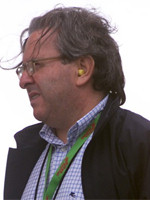 It all
began in 1983 when president
of one of the most successful european steel-producing company
Lucchini Group Giuzeppe Lucchini and his friend, former rally driver, Remo
Ramazzini founded a racing team called Brixia Motor Sport (Brixia is
an ancient Latin name of Brescia, a home town for both our heroes), or in
short - BMS. They run Alfa Romeo cars in Italian rally championship and
World touring cars championship. But in 1987 Alfa Romeo stopped supplying
cars for these series and this fact forced Lucchini to make a move to F1.
Lucchini Group was able to supply an acceptable funds, the team management
had a great enthusiasm. The only thing missing in this combination was a
car. The respective proposal was made to Gianpaolo Dallara, who's fabric
was located in neighbour Parma. Dallara already had some expirience of
developing F1 cars. He was involved in Frank Williams and Alessandro De
Tomaso F1 project in 1970-s. And he agreed to build a cars for BMS. It all
began in 1983 when president
of one of the most successful european steel-producing company
Lucchini Group Giuzeppe Lucchini and his friend, former rally driver, Remo
Ramazzini founded a racing team called Brixia Motor Sport (Brixia is
an ancient Latin name of Brescia, a home town for both our heroes), or in
short - BMS. They run Alfa Romeo cars in Italian rally championship and
World touring cars championship. But in 1987 Alfa Romeo stopped supplying
cars for these series and this fact forced Lucchini to make a move to F1.
Lucchini Group was able to supply an acceptable funds, the team management
had a great enthusiasm. The only thing missing in this combination was a
car. The respective proposal was made to Gianpaolo Dallara, who's fabric
was located in neighbour Parma. Dallara already had some expirience of
developing F1 cars. He was involved in Frank Williams and Alessandro De
Tomaso F1 project in 1970-s. And he agreed to build a cars for BMS.
1988: The beginning
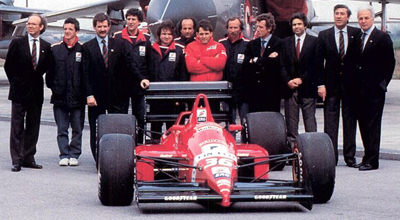 The first season in F1 for the new team
called BMS Scuderia Italia began with a DNQ in Brazil. They just
didn't have time to prepare the car. So, not to be fined by FISA for missing
a round, they decided to go to Rio with a last year's F3000 Dallara car
equipped with Ford Cosworth DFV engine and adapted to F1's technical
regulations. Of course, Alex Caffi, the one and only team's driver, had no
chance to break to the starting grid. But even if the miracle would happen,
he would never finish that race because of not enough capacity of fuel
tank! By the way, in 1987 the March team, that was making it's come back
to F1, has made the same trick. The first season in F1 for the new team
called BMS Scuderia Italia began with a DNQ in Brazil. They just
didn't have time to prepare the car. So, not to be fined by FISA for missing
a round, they decided to go to Rio with a last year's F3000 Dallara car
equipped with Ford Cosworth DFV engine and adapted to F1's technical
regulations. Of course, Alex Caffi, the one and only team's driver, had no
chance to break to the starting grid. But even if the miracle would happen,
he would never finish that race because of not enough capacity of fuel
tank! By the way, in 1987 the March team, that was making it's come back
to F1, has made the same trick.
The first real BMS Scuderia Italia F1 car
was presented to the public on April, 7th in Italian Air Force base
near Brescia. BMS-Dallara F188 was designed by Italo Montanari, Paolo
Montali, Nando Concari and Luigi Urbinelli ander direction of techincal
director Sergio Rinland who was on
vacations while Brabham, the team where he was a chief designer, has a
year off F1. The car was equipped with the same Cosworth DFV engine and
had nothing really unusual in it's design except the fact that it looked
very similar to Ferrari F87/88C. It's first race was San Marino
Grand Prix where Caffi retired on lap 53 due to gearbox failure. In
the rest of the season the car proven itself fast enough to qualify in every Grand Prix and reliable enough to get to the finish line. But it was unable to help Alex
Caffi to
score a single point.
1989 - 1990: No move
forward with old Cosworth engine
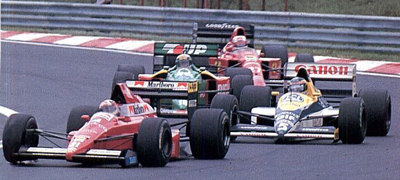 The expirience of the first season was
considered as positive and Lucchini increased a financing of the team.
They build a second car for Andrea de Cesaris who was getting ready
for his 10th season in F1. But there ware a losses too: Sergio Rinland
went back to Brabham so the new car was designed under the direction of
Gianpaolo Dallara himself. The car had a new suspension and engine module.
In the opening round of the season in Brazil Alex Caffi was unable to
pre-qualify due to the fuel pump failure. But already in the second race
at Imola he found himsilf standing on the 10th position on the grid that was a
huge success for a small team. He finished 7th in that race. At Monaco, on the track that usually shows more chassis advantages then
engine's lack of power, young Italian finished 4th scoring team's and
his personal first points ever. De Cesaris was in his usual way: he was showing
good results just if he managed not to crash the car. One of his 'trade
mark' accidents happened on lap 53 of Mexican Grand Prix when he,
trying to eliminate a lap gap, sent his teammate's car into the wall.
At that moment Caffi was running 5th and had real chances to finish on the podium. The atmosphere in the team
became very heated. The expirience of the first season was
considered as positive and Lucchini increased a financing of the team.
They build a second car for Andrea de Cesaris who was getting ready
for his 10th season in F1. But there ware a losses too: Sergio Rinland
went back to Brabham so the new car was designed under the direction of
Gianpaolo Dallara himself. The car had a new suspension and engine module.
In the opening round of the season in Brazil Alex Caffi was unable to
pre-qualify due to the fuel pump failure. But already in the second race
at Imola he found himsilf standing on the 10th position on the grid that was a
huge success for a small team. He finished 7th in that race. At Monaco, on the track that usually shows more chassis advantages then
engine's lack of power, young Italian finished 4th scoring team's and
his personal first points ever. De Cesaris was in his usual way: he was showing
good results just if he managed not to crash the car. One of his 'trade
mark' accidents happened on lap 53 of Mexican Grand Prix when he,
trying to eliminate a lap gap, sent his teammate's car into the wall.
At that moment Caffi was running 5th and had real chances to finish on the podium. The atmosphere in the team
became very heated.
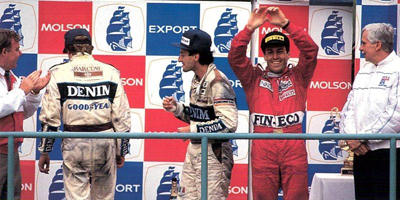 De Cesaris has deserved the team's
forgiveness on the next Grand Prix in Canada where he managed to finish
third just behind Thierry
Boutsen and Riccardo
Patrese in completely mad wet race. Caffi was 6th and plunged the team
into euphoria. But this was team's last points that year. Thanks to this
successes BMS was freed from pre-qualifying sessions in the second half of
the season, but after Canada neither
Caffi nor De Cesaris managed to finish in the top six. The only good
result was 7th place in Hungary but this once again shown team's biggest
problem - the old and weak engine. De Cesaris has deserved the team's
forgiveness on the next Grand Prix in Canada where he managed to finish
third just behind Thierry
Boutsen and Riccardo
Patrese in completely mad wet race. Caffi was 6th and plunged the team
into euphoria. But this was team's last points that year. Thanks to this
successes BMS was freed from pre-qualifying sessions in the second half of
the season, but after Canada neither
Caffi nor De Cesaris managed to finish in the top six. The only good
result was 7th place in Hungary but this once again shown team's biggest
problem - the old and weak engine.
During January'90 Scuderia was left by
it's chief designer Mario Tolentino, who gone to develop the car for a new
team Gonzalez Luna & Association, that turn out to be a Lamborghini's
F1 project. So the new Dallara F190 for upcoming season was designed by
Christian Vanderplain, who came to team after Coloni infamously left F1.
He was BMS' third chief designer for three years. New F190 was a product of
further development of the last year's car. But all efforts of
constructors was useless because of the same old Cosworth DFR engine. Also
Alex Caffi, who proven himself to be a rising star, gone to Arrows. He was
replaced by another Italian Emmanuele Pirro. Pirro made his F1 debut in 1989
with Benetton but didn't shown good results and was sacked by the end of
season. Also Emmanuele had very special relationships with Andrea De Cesaris
after he beaten Pirro off Japanese Grand Prix'89.
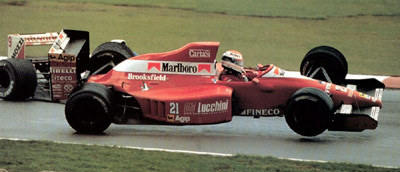 But in spite of these non-optimistic
circumstances the new championship began just great for BMS: De Cesaris
managed to show the 3rd time in qualifying of the season opening US Grand
Prix. This fact explained very simply - Phoenix street track suited
Scuderia's Pirelly tyres very well. The only car with Good Year rubber in
first four was Gerhard
Berger's McLaren stading on the pole. But in race De Cesaris retired
with the failed engine. During first two rounds diseased Emmanuele Pirro
was replaced by Gianni
Morbidelli, who made his debut in F1. It was not too successive: one
DNQ and one retirement. The things didn't became better with Pirro's
return: 11 retirements for Emmanuele and 12 plus 1 DNQ for De Cesaris.
That was a disaster. It become completely clear that Scuderia has no
future with Cosworth engines. But in spite of these non-optimistic
circumstances the new championship began just great for BMS: De Cesaris
managed to show the 3rd time in qualifying of the season opening US Grand
Prix. This fact explained very simply - Phoenix street track suited
Scuderia's Pirelly tyres very well. The only car with Good Year rubber in
first four was Gerhard
Berger's McLaren stading on the pole. But in race De Cesaris retired
with the failed engine. During first two rounds diseased Emmanuele Pirro
was replaced by Gianni
Morbidelli, who made his debut in F1. It was not too successive: one
DNQ and one retirement. The things didn't became better with Pirro's
return: 11 retirements for Emmanuele and 12 plus 1 DNQ for De Cesaris.
That was a disaster. It become completely clear that Scuderia has no
future with Cosworth engines.
1991: Out of Cosworth
irons.
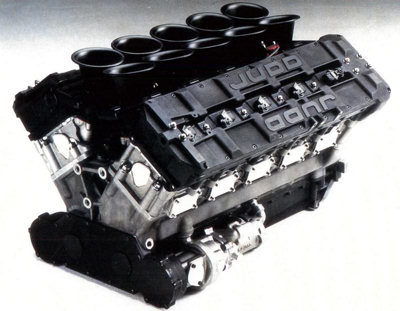 Scuderia Italia's new engine - Judd -
of course wasn't the most powerful engine of the championship but it had
40 hp more than Cosworth and that was a big step forward for the team.
John Judd's company was involved in F1 for a very long time: he began with
tuning Cosworth and Coventry Climax engines for different F1 teams in
1960s, than he was developing engines for F2, F3000 and Indycars and
finally presented his own engine in F1 in 1988 when March and Williams
equipped with it placed respectively 6th and 7th in Constructors Cup
having scored 22 and 20 pts. In 1989 Judd lost both Williams and March,
but recieved Lotus, Ligier and Brabham. And again all Judd-powered teams
placed higher in Constructors Cup than Cosworth clients. So Lucchini made
a good deal by signing Judd for engine supplying. Scuderia Italia's new engine - Judd -
of course wasn't the most powerful engine of the championship but it had
40 hp more than Cosworth and that was a big step forward for the team.
John Judd's company was involved in F1 for a very long time: he began with
tuning Cosworth and Coventry Climax engines for different F1 teams in
1960s, than he was developing engines for F2, F3000 and Indycars and
finally presented his own engine in F1 in 1988 when March and Williams
equipped with it placed respectively 6th and 7th in Constructors Cup
having scored 22 and 20 pts. In 1989 Judd lost both Williams and March,
but recieved Lotus, Ligier and Brabham. And again all Judd-powered teams
placed higher in Constructors Cup than Cosworth clients. So Lucchini made
a good deal by signing Judd for engine supplying.
By the end of 1990 Andrea De Cesaris was
discharged and replaced with Finn J.J.
Lehto, first non-Italian driver in BMS. Last year's car design was
considered as non-successful and it's author Christian Vanderplain was
forced to leave BMS. Dallara F191 for a new season was designed by Paolo
Stanzani with aerodynamic work was fulfilled by Nigel Cowperthwaite.
Although the new car again was an evolution of it's predecessor it looked
completely different. 'If the car would be painted white no one would
suspect that it's a Dallara' - said Pirro. By the will of Cowperthwaite the
car recieved a completely new aerodynamic livery with a raised nose and sidepods of
an unusual form. Also it had a
completely new monocoque and rear suspension.
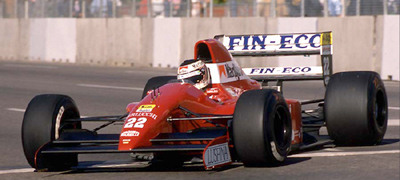 Such a renewal brought a success: at San
Marino Lehto managed to finish 3rd again in wet. Two weeks later in Monaco
Pirro was 6th. 5 points in first four races against 0 for whole last
season! But once again in the second half of the season BMS' result became
worse. 'The problem was in our inability to achieve the improvement in
car's characteristics during the season. We didn't have enough funds for
it. And while our rivals was progressing Scuderia stayed at the same level.
The situation was very bad. For example in Friday practice we had to use
the engine that we used in last race! We hadn't a spare for it!' -
Gianpaolo Dallara recalls. Such a renewal brought a success: at San
Marino Lehto managed to finish 3rd again in wet. Two weeks later in Monaco
Pirro was 6th. 5 points in first four races against 0 for whole last
season! But once again in the second half of the season BMS' result became
worse. 'The problem was in our inability to achieve the improvement in
car's characteristics during the season. We didn't have enough funds for
it. And while our rivals was progressing Scuderia stayed at the same level.
The situation was very bad. For example in Friday practice we had to use
the engine that we used in last race! We hadn't a spare for it!' -
Gianpaolo Dallara recalls.
But suddenly the new hope came to BMS
with Ferrari engines. In
1991 Ferrari supplied it's powerplants to Minardi. But the result was
unsutisfying: small squad managed to score only 6 pts, all by Pierluigi
Martini. And Ferrari decided to change a client and chose BMS Dallara.
With new engines Scuderia Italia recieved a new driver - Pierluigi Martini,
who replaced Emmanuele Pirro. In abcense of any suitable results Pirro was
forced to leave F1. Intresting fact: in his last race Emmanuele retired in
collision with... Andrea
De Cesars, now driving Jordan!!!
1992: The new hope.
But there was a sceptic voices too. They
said that Ferrari engines are undoubtedly very perspective and powerful
but ithey're too complex in maintenance and that will be the main and
biggest problem for a small team like BMS. And last year's Minardi result
confirms it.
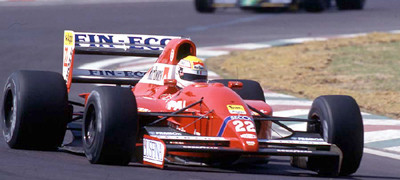 And they were right. On the starting grid
of 1992 South African Grand Prix J.J.Lehto and Pierluigi Martini was
standing respectively 24th and 25th. Later things come a little better:
Ferrari presented a new 1992-spec engine and Dallara F192 moved to the
middle of the grid. Finally at Spain Martini managed to finish 6th. Two
weeks later he repeated it at San Marino by making a little feat: in 20
laps before the finish he lost a water supply and finished in
half-unconscious condition. This became Scuderia Italia's last point this
season and, as it become clear later, at all. Though J.J.Lehto didn't had
any problems with car reliability he didn't managed to score a point this
year. Both drivers was constantly complaining about the car's lack of
speed and difficulties in it's setup. Actually the car was so bad that
it's designer Nigel Cowperthwaite left the team already in the spring
having no job proposals at all! So the new top-line engine didn't bring
BMS to the new level. So, something needed to be changed. And they were right. On the starting grid
of 1992 South African Grand Prix J.J.Lehto and Pierluigi Martini was
standing respectively 24th and 25th. Later things come a little better:
Ferrari presented a new 1992-spec engine and Dallara F192 moved to the
middle of the grid. Finally at Spain Martini managed to finish 6th. Two
weeks later he repeated it at San Marino by making a little feat: in 20
laps before the finish he lost a water supply and finished in
half-unconscious condition. This became Scuderia Italia's last point this
season and, as it become clear later, at all. Though J.J.Lehto didn't had
any problems with car reliability he didn't managed to score a point this
year. Both drivers was constantly complaining about the car's lack of
speed and difficulties in it's setup. Actually the car was so bad that
it's designer Nigel Cowperthwaite left the team already in the spring
having no job proposals at all! So the new top-line engine didn't bring
BMS to the new level. So, something needed to be changed.
1993: A revolution
turned into crash.
 By the end of 1992
Beppe Lucchini was
completely uncatisfied with team's results. BMS had Ferrari engines, one
of the most powerful in F1 at the moment, but Scuderia's drivers were fighting
for positions in the end of top ten and scoring point only from time
to time. So, if Dallara cannot build a fast car for a mighty engine, all we have to do is to change a chassis manufacturer - maybe this
way Lucchini was thinking during winter'92. And the next season BMS has
began
running Lola chassis. By the end of 1992
Beppe Lucchini was
completely uncatisfied with team's results. BMS had Ferrari engines, one
of the most powerful in F1 at the moment, but Scuderia's drivers were fighting
for positions in the end of top ten and scoring point only from time
to time. So, if Dallara cannot build a fast car for a mighty engine, all we have to do is to change a chassis manufacturer - maybe this
way Lucchini was thinking during winter'92. And the next season BMS has
began
running Lola chassis.
The new Lola T93/30 was finished too late
before the start of the season in the South Africa, so Scuderia Italia didn't have
enough time for testing. From aside the car was looking a bit like IndyCar
machines - it was too massive. And it's filling wasn't better than it's look -
Lola have no active ride suspension and almost no electronics at all! The
car was powered with last year spec Ferrari E1 A92 V12 engine. It has over
740 hp and revving up to 14700 rpm. Also BMS Lola has fully changed it's
drivers line-up. 1992 F3000 Champion Luca
Badoer was taken in place of J.J. Lehto, gone to newcomer
Sauber team, and veteran Michele
Alboreto has replaced Pierluigi
Martini who wasn't able to find a drive for 1993. Also Scuderia Italia
has changed it's colors - the cars recieved a new sharp-looking
Chesterfield livery. It was almost revolution - the new car, new colors,
new drivers. The expectations was very high - Guizeppe Lucchini was
talking about podiums...
The reality was shocking. On the starting
grid of South African Grand Prix two Lolas
were standing on the last row.
Alboreto and Badoer has lost respectively 1 and almost 4 seconds to Fabrizio
Barbazza in Minardi
who was 24th. In race both cars has retired with technical problems. And
so on. The team's best result in 1993 was Luca Badoer's 7th place on the
finish of San
Marino Grand Prix. When the new qualifying rule was introduced (the driver
clocked the worst time doesn't get to the start of the race) Italian team has
become it's only victim. Badoer was not qualified twice, Alboreto - 5
times. In the middle of the season Ferrari has announced that they won't
supply engines for BMS in 1994. In a short time after that Lola has
refused to continue collaboration with Italian squad too. This was the end.
BMS retired from F1 in two rounds before the end of 1993 championship.
 During winter'93 Lucchini has
anounced
that BMS will join it's forces with Minardi. The new team will be named
Minardi Scuderia Italia and it's cars will be driven by Pierluigi Martini
and Michele Alboreto, while
Luca Badoer will became a test driver. But
this was just an attempt to save it's face - Lucchini was imperferate to
Minardi's operation in 1994 and all that left from BMS Scuderia Italia -
is the writing on Minardi M194 sidepod. During winter'93 Lucchini has
anounced
that BMS will join it's forces with Minardi. The new team will be named
Minardi Scuderia Italia and it's cars will be driven by Pierluigi Martini
and Michele Alboreto, while
Luca Badoer will became a test driver. But
this was just an attempt to save it's face - Lucchini was imperferate to
Minardi's operation in 1994 and all that left from BMS Scuderia Italia -
is the writing on Minardi M194 sidepod.
1994 - 2002: Alive
and kickin'!
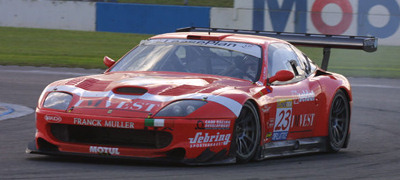 This was the end of BMS' F1 programme.
Fortunately it didn't became the end for whole Scuderia Italia team.
Giuzeppe Lucchini still is a big fan of motorsport and his squad still
alive and working. After F1 fiasco BMS was presented in Italian
superturism
championship for several years running Nissan Primera with Ivan
Capelli as No.1 driver. After that they switched to misc sportcars
racing. Last year (2002) BMS competed in FIA GT Championship with
two Ferrari 550 GTS Maranello machines one of wich was driven by Andrea
Piccini and Jean
Denis Deletraz. This crew won 4 races - at Jarama, Anderstop,
Oschersleben and Estoril - and placed 5/6th in Drivers Standing while
Scuderia Italia become 4th in team's standing. This was the end of BMS' F1 programme.
Fortunately it didn't became the end for whole Scuderia Italia team.
Giuzeppe Lucchini still is a big fan of motorsport and his squad still
alive and working. After F1 fiasco BMS was presented in Italian
superturism
championship for several years running Nissan Primera with Ivan
Capelli as No.1 driver. After that they switched to misc sportcars
racing. Last year (2002) BMS competed in FIA GT Championship with
two Ferrari 550 GTS Maranello machines one of wich was driven by Andrea
Piccini and Jean
Denis Deletraz. This crew won 4 races - at Jarama, Anderstop,
Oschersleben and Estoril - and placed 5/6th in Drivers Standing while
Scuderia Italia become 4th in team's standing.
After break with BMS F1
project Gianpaolo Dallara managed not to loose his company and fall into
bunkruptcy like Reynard. 'I never invested too much money in F1. I gave
then our technical support, our techincal and intellectual recources.
Actually we spent on F1 about 30% of our abilities.' - Gianpaolo recalls.
Now Dallara is one of the most successful motorsport companies. It's
building chassis for a many racing series, like F3, Formula Super Nissan,
IRL. Famous Audi R8 prototypes that won last three Le Mans 24hr races are
too designed by Dallara. In 1999 Dallara built a fabulous F1 car for Honda
that beaten all it's rivals already in it's first test session! But after
Harvey Postelethwaite's death Japanese company decided to limit it's F1
project with only engine supplying.
After a crash with
Scuderia Italia Eric Broadley, the Lola's founder, didn't left his dream
to present Lola cars in F1. While supplying cars for CART and F3000
championships he was planning his own F1 team. In 1995 he built new F1
prototype and even engaged a driver - Allan
McNish. But funds always was a big problem. Finally in 1997 he made a
break into F1 with Mastercard support and two drivers Riccardo
Rosset and Vincenco Sospiri. But the car was too weak. Both drivers
was not qualified. In severals weeks Lola was ruined and sold out. But
it's still alive and still producing cars for F3000, CART, ALMS and other
series.
(c) F1
A.D.
|
 It all
began in 1983 when president
of one of the most successful european steel-producing company
Lucchini Group Giuzeppe Lucchini and his friend, former rally driver, Remo
Ramazzini founded a racing team called Brixia Motor Sport (Brixia is
an ancient Latin name of Brescia, a home town for both our heroes), or in
short - BMS. They run Alfa Romeo cars in Italian rally championship and
World touring cars championship. But in 1987 Alfa Romeo stopped supplying
cars for these series and this fact forced Lucchini to make a move to F1.
Lucchini Group was able to supply an acceptable funds, the team management
had a great enthusiasm. The only thing missing in this combination was a
car. The respective proposal was made to Gianpaolo Dallara, who's fabric
was located in neighbour Parma. Dallara already had some expirience of
developing F1 cars. He was involved in Frank Williams and Alessandro De
Tomaso F1 project in 1970-s. And he agreed to build a cars for BMS.
It all
began in 1983 when president
of one of the most successful european steel-producing company
Lucchini Group Giuzeppe Lucchini and his friend, former rally driver, Remo
Ramazzini founded a racing team called Brixia Motor Sport (Brixia is
an ancient Latin name of Brescia, a home town for both our heroes), or in
short - BMS. They run Alfa Romeo cars in Italian rally championship and
World touring cars championship. But in 1987 Alfa Romeo stopped supplying
cars for these series and this fact forced Lucchini to make a move to F1.
Lucchini Group was able to supply an acceptable funds, the team management
had a great enthusiasm. The only thing missing in this combination was a
car. The respective proposal was made to Gianpaolo Dallara, who's fabric
was located in neighbour Parma. Dallara already had some expirience of
developing F1 cars. He was involved in Frank Williams and Alessandro De
Tomaso F1 project in 1970-s. And he agreed to build a cars for BMS. The first season in F1 for the new team
called BMS Scuderia Italia began with a DNQ in Brazil. They just
didn't have time to prepare the car. So, not to be fined by FISA for missing
a round, they decided to go to Rio with a last year's F3000 Dallara car
equipped with Ford Cosworth DFV engine and adapted to F1's technical
regulations. Of course, Alex Caffi, the one and only team's driver, had no
chance to break to the starting grid. But even if the miracle would happen,
he would never finish that race because of not enough capacity of fuel
tank! By the way, in 1987 the March team, that was making it's come back
to F1, has made the same trick.
The first season in F1 for the new team
called BMS Scuderia Italia began with a DNQ in Brazil. They just
didn't have time to prepare the car. So, not to be fined by FISA for missing
a round, they decided to go to Rio with a last year's F3000 Dallara car
equipped with Ford Cosworth DFV engine and adapted to F1's technical
regulations. Of course, Alex Caffi, the one and only team's driver, had no
chance to break to the starting grid. But even if the miracle would happen,
he would never finish that race because of not enough capacity of fuel
tank! By the way, in 1987 the March team, that was making it's come back
to F1, has made the same trick. The expirience of the first season was
considered as positive and Lucchini increased a financing of the team.
They build a second car for
The expirience of the first season was
considered as positive and Lucchini increased a financing of the team.
They build a second car for  De Cesaris has deserved the team's
forgiveness on the next Grand Prix in Canada where he managed to finish
third just behind
De Cesaris has deserved the team's
forgiveness on the next Grand Prix in Canada where he managed to finish
third just behind  But in spite of these non-optimistic
circumstances the new championship began just great for BMS: De Cesaris
managed to show the 3rd time in qualifying of the season opening US Grand
Prix. This fact explained very simply - Phoenix street track suited
Scuderia's Pirelly tyres very well. The only car with Good Year rubber in
first four was
But in spite of these non-optimistic
circumstances the new championship began just great for BMS: De Cesaris
managed to show the 3rd time in qualifying of the season opening US Grand
Prix. This fact explained very simply - Phoenix street track suited
Scuderia's Pirelly tyres very well. The only car with Good Year rubber in
first four was  Scuderia Italia's new engine - Judd -
of course wasn't the most powerful engine of the championship but it had
40 hp more than Cosworth and that was a big step forward for the team.
John Judd's company was involved in F1 for a very long time: he began with
tuning Cosworth and Coventry Climax engines for different F1 teams in
1960s, than he was developing engines for F2, F3000 and Indycars and
finally presented his own engine in F1 in 1988 when March and Williams
equipped with it placed respectively 6th and 7th in Constructors Cup
having scored 22 and 20 pts. In 1989 Judd lost both Williams and March,
but recieved Lotus, Ligier and Brabham. And again all Judd-powered teams
placed higher in Constructors Cup than Cosworth clients. So Lucchini made
a good deal by signing Judd for engine supplying.
Scuderia Italia's new engine - Judd -
of course wasn't the most powerful engine of the championship but it had
40 hp more than Cosworth and that was a big step forward for the team.
John Judd's company was involved in F1 for a very long time: he began with
tuning Cosworth and Coventry Climax engines for different F1 teams in
1960s, than he was developing engines for F2, F3000 and Indycars and
finally presented his own engine in F1 in 1988 when March and Williams
equipped with it placed respectively 6th and 7th in Constructors Cup
having scored 22 and 20 pts. In 1989 Judd lost both Williams and March,
but recieved Lotus, Ligier and Brabham. And again all Judd-powered teams
placed higher in Constructors Cup than Cosworth clients. So Lucchini made
a good deal by signing Judd for engine supplying. Such a renewal brought a success: at San
Marino Lehto managed to finish 3rd again in wet. Two weeks later in Monaco
Pirro was 6th. 5 points in first four races against 0 for whole last
season! But once again in the second half of the season BMS' result became
worse. 'The problem was in our inability to achieve the improvement in
car's characteristics during the season. We didn't have enough funds for
it. And while our rivals was progressing Scuderia stayed at the same level.
The situation was very bad. For example in Friday practice we had to use
the engine that we used in last race! We hadn't a spare for it!' -
Gianpaolo Dallara recalls.
Such a renewal brought a success: at San
Marino Lehto managed to finish 3rd again in wet. Two weeks later in Monaco
Pirro was 6th. 5 points in first four races against 0 for whole last
season! But once again in the second half of the season BMS' result became
worse. 'The problem was in our inability to achieve the improvement in
car's characteristics during the season. We didn't have enough funds for
it. And while our rivals was progressing Scuderia stayed at the same level.
The situation was very bad. For example in Friday practice we had to use
the engine that we used in last race! We hadn't a spare for it!' -
Gianpaolo Dallara recalls. And they were right. On the starting grid
of 1992 South African Grand Prix J.J.Lehto and Pierluigi Martini was
standing respectively 24th and 25th. Later things come a little better:
Ferrari presented a new 1992-spec engine and Dallara F192 moved to the
middle of the grid. Finally at Spain Martini managed to finish 6th. Two
weeks later he repeated it at San Marino by making a little feat: in 20
laps before the finish he lost a water supply and finished in
half-unconscious condition. This became Scuderia Italia's last point this
season and, as it become clear later, at all. Though J.J.Lehto didn't had
any problems with car reliability he didn't managed to score a point this
year. Both drivers was constantly complaining about the car's lack of
speed and difficulties in it's setup. Actually the car was so bad that
it's designer Nigel Cowperthwaite left the team already in the spring
having no job proposals at all! So the new top-line engine didn't bring
BMS to the new level. So, something needed to be changed.
And they were right. On the starting grid
of 1992 South African Grand Prix J.J.Lehto and Pierluigi Martini was
standing respectively 24th and 25th. Later things come a little better:
Ferrari presented a new 1992-spec engine and Dallara F192 moved to the
middle of the grid. Finally at Spain Martini managed to finish 6th. Two
weeks later he repeated it at San Marino by making a little feat: in 20
laps before the finish he lost a water supply and finished in
half-unconscious condition. This became Scuderia Italia's last point this
season and, as it become clear later, at all. Though J.J.Lehto didn't had
any problems with car reliability he didn't managed to score a point this
year. Both drivers was constantly complaining about the car's lack of
speed and difficulties in it's setup. Actually the car was so bad that
it's designer Nigel Cowperthwaite left the team already in the spring
having no job proposals at all! So the new top-line engine didn't bring
BMS to the new level. So, something needed to be changed. By the end of 1992
Beppe Lucchini was
completely uncatisfied with team's results. BMS had Ferrari engines, one
of the most powerful in F1 at the moment, but Scuderia's drivers were fighting
for positions in the end of top ten and scoring point only from time
to time. So, if Dallara cannot build a fast car for a mighty engine, all we have to do is to change a chassis manufacturer - maybe this
way Lucchini was thinking during winter'92. And the next season BMS has
began
running Lola chassis.
By the end of 1992
Beppe Lucchini was
completely uncatisfied with team's results. BMS had Ferrari engines, one
of the most powerful in F1 at the moment, but Scuderia's drivers were fighting
for positions in the end of top ten and scoring point only from time
to time. So, if Dallara cannot build a fast car for a mighty engine, all we have to do is to change a chassis manufacturer - maybe this
way Lucchini was thinking during winter'92. And the next season BMS has
began
running Lola chassis. During winter'93 Lucchini has
anounced
that BMS will join it's forces with Minardi. The new team will be named
Minardi Scuderia Italia and it's cars will be driven by
During winter'93 Lucchini has
anounced
that BMS will join it's forces with Minardi. The new team will be named
Minardi Scuderia Italia and it's cars will be driven by  This was the end of BMS' F1 programme.
Fortunately it didn't became the end for whole Scuderia Italia team.
Giuzeppe Lucchini still is a big fan of motorsport and his squad still
alive and working. After F1 fiasco BMS was presented in Italian
superturism
championship for several years running Nissan Primera with
This was the end of BMS' F1 programme.
Fortunately it didn't became the end for whole Scuderia Italia team.
Giuzeppe Lucchini still is a big fan of motorsport and his squad still
alive and working. After F1 fiasco BMS was presented in Italian
superturism
championship for several years running Nissan Primera with